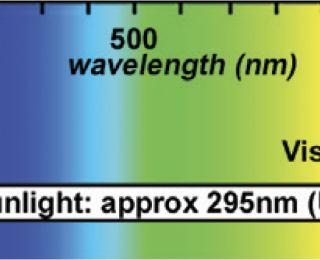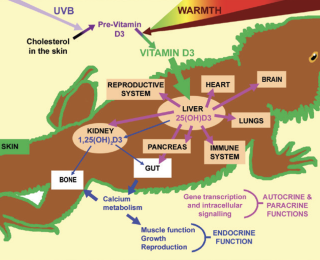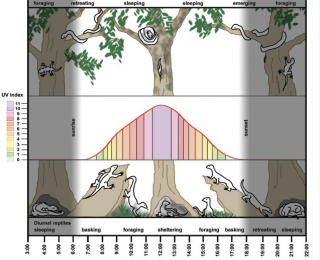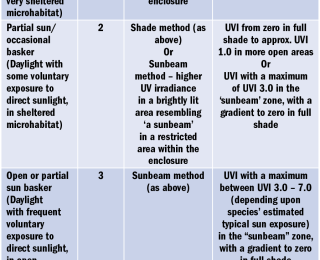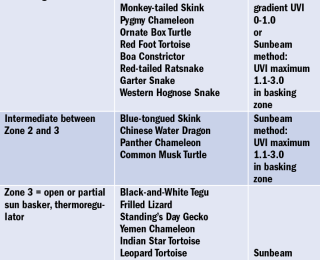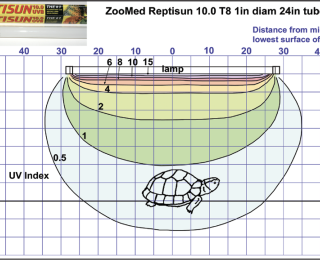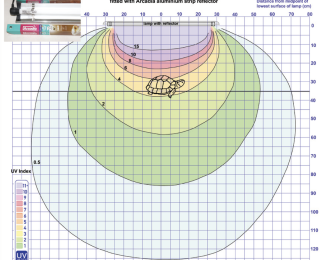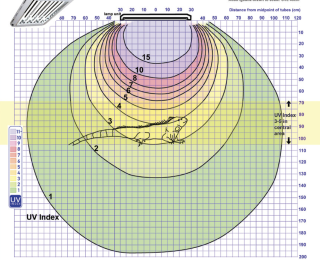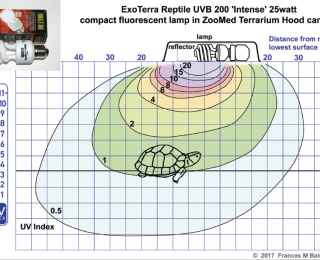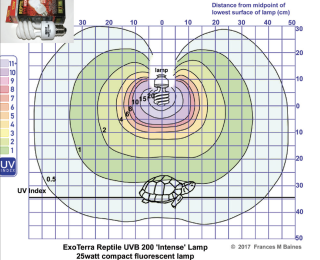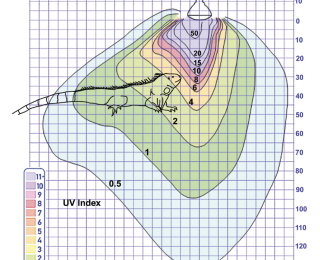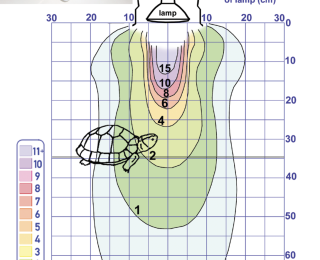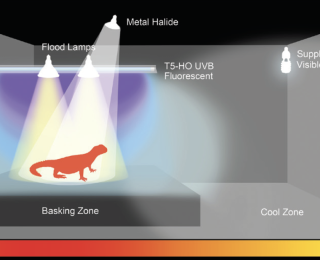Small animal - January 2020
An introduction to ultraviolet and Vitamin D3 deficiency
Frances M Baines MA Vet MB MRCVS provides a comprehensive guide to ultraviolet light and vitamin D deficiency
Vitamin D3 insufficiency and, even severe deficiency leading to metabolic bone disease or 'rickets', are still extremely common in many animals housed indoors – mammals, reptiles or birds. Species from tropical countries that would naturally be exposed to strong sunlight with maximum opportunity for cutaneaous vitamin D3 synthesis are most at risk. However, even domestic animals such as cattle and sheep, and pets such as rabbits and cage birds have evolved to obtain most, if not all of their vitamin D3, from cutaneous synthesis. Ensuring adequate levels using dietary supplements can be difficult. When exposure to natural sunlight is limited, providing species-appropriate levels of UV can be of great benefit – and not just for acquiring vitamin D3. Many private keepers, as well as zoos, are installing modern, fullspectrum lighting, which includes UVA and UVB, to improve the welfare of animals housed indoors. However, two important questions need answering: how much UV is needed, and what lamps will be suitable
What is ultraviolet?
Ultraviolet (UV) is simply a normal part of the light from the sun. Physicists subdivide it by wavelength: a long-wavelength fraction UVA (320-400 nm); a short-wavelength fraction UVB (280-320nm); and a very short-wavelength fraction UVC (100-280nm). Fortunately, for life on earth, our atmosphere filters out harmful short-wavelength radiation below about 290-295nm (Figure 1). Every part of the sunlight that the atmosphere does let through, however, is utilised by life on earth.
UVA
UV gets its name because its wavelengths have only slightly greater energy than the wavelengths we see as violet light. Most reptiles, many birds and even some mammals can see UVA, invisible to us. Just as we do, animals recognise other animals and food items by their colours and markings, many of which include UVA-colour. This is why providing lighting containing UVA is an essential part of husbandry for many species. Natural sunlight, not filtered by glass, has a considerable UVA content. Normal window glass blocks up to 50% of this.
Ordinary incandescent lamps and halogen basking lamps emit small amounts of UVA. Metal halide bulbs are particularly good sources, which together with their extremely high output of visible light makes them excellent simulators of sunlight. All UVB reptile lamps also emit UVA. Lamps, which don’t emit it, such as white and coloured LEDs and red heat lamps, don’t allow full colour vision to species that can see UVA.
UVB
UVB is invisible to almost all vertebrates, but its high-energy short wavelengths are biologically active. The UV in sunlight is an effective disinfectant that can destroy bacteria, fungi and viruses on the surface of the skin. UV also has direct effects upon skin, which include strengthening of skin barrier functions, increasing pigment formation and modulating the skin’s immune responses. It also stimulates production of beta endorphins, giving sunlight its ‘feel good’ factor, and induces nitric oxide production, which has localised, protective effects on skin cells.
Perhaps the most well-known and most vital effect of UVB, however, is its ability to convert a natural cholesterol in the skin to pre-vitamin D3. Warmth, typically also absorbed while basking, converts the pre-vitamin D3 to vitamin D3.
Vitamin D3 is used for vital functions throughout the body (Figure 2). It is taken up from the skin into the bloodstream, and carried to the liver, where it is converted into a storage form, called 25(OH)D3. This then re-enters the bloodstream and is carried all round the body. A blood test for 25(OH)D3 is the best way of measuring an animal’s vitamin D3 status.
A small amount of this 25(OH)D3 is essential for life. It is processed by the kidneys into the active hormone, 1,25(OH)2D3 (Figure 2 – blue arrows). This vital endocrine hormone controls the levels of calcium in the bloodstream. Adequate circulating calcium is absolutely essential for muscles and nerves to function, and is also vital for normal growth and reproduction. 1,25(OH)D3 enables the gut to absorb calcium from the diet and maintains stores of calcium laid down in bone. If an animal develops metabolic bone disorder (MBD) as a result of vitamin D3 deficiency, this means that levels were desperately low, not even sufficient to make the tiny amounts of active hormone so necessary for life.
However, when supplies of vitamin D3 are plentiful, other organs can take up 25(OH)D3, and even vitamin D3 itself, and turn it into the active form inside their cells (Figure 2 – pink arrows). There, it controls as many as 2,000 genes influencing a huge range of functions including cell division and the immune system. Adequate vitamin D3 is therefore needed for full health; not just the bare minimum that keeps MBD at bay.
Wild animals do not get MBD because they have a ready supply of vitamin D3, produced in daylight and/or sunlight. The natural way that most animals living on the surface of the earth obtain their vitamin D3 is believed to be from synthesis in their skin when it is exposed to UVB during daylight hours. Carnivorous animals also obtain a supply from the bodies of their prey, so in captivity they can survive on this alone, especially if vitamin D3 supplements are added. Vitamin D3 is not found in plants or in commercially farmed insects. Most, but not all, herbivores and insectivores kept in captivity can also use vitamin D3 from supplements, but this is not the main way they obtain it in the wild.
What about nocturnal animals?
It is often said that crepuscular and nocturnal species are never out in sunlight, and so they do not benefit from UV. However, many species traditionally classified as nocturnal may, in fact, be cathemeral (irregularly active at any time of night or day) and many even bask in full sunlight at certain times of day. In the wild, even those which are rarely active when the sun is above the horizon may spend the day sleeping in places where daylight, which includes UV, filters through. Levels of UVB in daylight reaching deeply shaded places may be very low, but the animals are receiving it for many hours each day. Some species also appear to have very low vitamin D3 requirements. Figure 3 is a cartoon to illustrate how behavioral differences result in very different daily UV exposures.
The intensity of UV in sunlight is determined by the height of the sun in the sky, because at low solar altitudes the rays must pass through a thicker layer of atmosphere, which selectively absorbs and scatters shorter wavelengths. Under clear skies, UV levels rise from zero at dawn to a maximum around noon, then fall again to zero at sunset. The chart shows actual UV recordings from Flinders Ranges, South Australia, one clear day in October, as recorded by the author standing in full sunlight. Few animals expose themselves to the strongest mid-day UV levels. This is important – when supplying UVB in captivity, we must offer only the levels they choose to experience in the wild, which depends upon both their habitat and their natural behaviour and basking patterns (if any).
We need to ensure that our enclosures allow their inhabitants the freedom to self-regulate their exposure to heat, light and UV within the range that is appropriate for the species. In the wild, sunlight interacts with features such as trees, rocks, plants and water, creating superimposed gradients of heat, light and UV extending from full sunlight into full shade. Providing similar gradients in the enclosure is the key to success and, since the heat, light and UV received from a lamp is proportional to its distance from the subject, it is possible to select a product, or combination of products, to create almost any desired effect.
How do we find out how much UVB is needed?
The UV Index (UVI), can be measured with a Solarmeter 6.5 (or 6.5R) UV Index meter. This meter is especially useful. It measures UV irradiance in the wavelengths, which enable vitamin D3 synthesis. The UVI scale is also easy to remember, and may be familiar owing to its use in weather forecasting.
Very little research has been conducted on the natural levels of UV experienced daily by any species of mammals or birds, and only a handful of papers describe the photo-microhabitat of reptiles and amphibians. In the absence of any data regarding suitable UV levels for a given species, the ‘Ferguson Zones’ devised for reptiles and amphibians inhabiting different photo-microhabitats, might possibly be used as a starting point for ball-park figures (Ferguson et al, 2010; Baines et al, 2016). For example, species which live out in the open, sunlit savannah or sun-basking species might benefit from ‘a zone of artificial sunlight’ suitable for Ferguson Zone 3 animals; those native to open woodlands, living in dappled sunlight, might be treated as Ferguson Zone 2 species and provided with ‘patches of artificial sunlight’ in a well-planted enclosure, and so on. UV Index levels suggested in the current BIAZA guide for reptiles and amphibians (Baines et al., 2016) may be summarised as follows:
Although some zone 3 and 4 animals can be observed in the wild out in full mid-day sunlight when UV levels in the tropics can easily exceed UVI 7.0-8.0, most animals spend the majority of their time at far lower levels, throughout the early morning and late afternoon, when maximum levels rarely exceed UVI 3.0-5.0. Since the UV spectrum from artificial lighting is not the same as from natural sunlight, the BIAZA UV recommendations state that, for safety, UVI 7.0-8.0 should be considered the absolute maximum exposure permitted under artificial lighting, and in practice, ‘morning sunlight’ levels, between UVI 3.0-5.0, should be adequate for most animals. Some Ferguson Zone allocations from Baines et al. (2016) are shown in Table 2. All guidelines to date are still very experimental, especially with mammals and birds, and it is vital to watch the animals’ responses and record results. NB: Albino and hypomelanistic animals are often more sensitive to UV and visible light, and are likely to need much reduced exposure levels.
Keepers should use their own UVI readings (eg. from a Solarmeter 6.5) to aid positioning of a UV lamp, since the output of individual lamps varies with a range of factors including age, temperature and electricity supply, and even between factory batches.
What type of lamps to use?
Figures 4A to 4G are iso-irradiance charts; scale drawings of the UV Index gradients plotted for a selection of lamps of various types used for supplying UVB to reptiles in captivity. Brands vary widely in output and beam shape; these are just examples drawn for individual lamps from well-known brands. However, lamps can be broadly divided into two groups; those suitable for use with shade dwellers, and those which can provide a ‘sunbeam’ for basking species.
1. Shade method
Covering large areas with low-level ‘background’ UVB resembling ‘outdoors in the shade’
Fluorescent T8 (1” diameter) UVB tubes may be suitable in many situations; or T5-HO tubes if positioned at much greater distances.
Aim for a UV Index up to approximately 1.0 at the closest access point.
2. Sunbeam method
Producing a smaller area – in a basking zone – with high-level UVB resembling ‘a patch of direct sunlight’.
Mercury Vapour lamps, Metal Halide UVB lamps, T5-High Output Fluorescent Tubes – UV Index ideally around 3.0-5.0 in the basking area may be suitable for sun basking species. A maximum of around 7.0 at the closest access point should still be safe.
Please remember:
- Shade is vital, even Zone 4 animals must have a UV gradient falling to zero in shelters away from the light. Basking temperatures and ambient temperatures must be suitable, to ensure basking behaviours – and therefore UV exposure times – are natural – neither abnormally short nor prolonged.
- The exact UV requirements of reptiles and amphibians are still largely unknown, and the use of UVB lighting for mammals and birds is still experimental.
- Figure 5 is a diagram of a basking zone created for a small reptile in Ferguson Zone 3 or 4, using a combination of a T5-HO UVB fluorescent tube for UVB, with incandescent basking lamps and a non-UVB metal halide lamp for visible light and heat. Creating a really well-lit enclosure is not possible using just one lamp. A combination of lamps, bulbs and tubes, used with care and sensitivity, can go a long way towards bringing ‘sunlight’ indoors, and meeting the needs of all animals in captivity.
Some final points to consider: - Watch your animals, trust their judgement, and record your results!
- Fluorescent lamps and mercury vapour lamps have poor colour rendering and should be combined with either incandescent lamps or metal halides, to improve the visible light.
- Lamps should always be positioned above the animal, so its upper eyelids, ridges above the eyes and eye orientation shade the pupils from the direct light.
- All lamps present an electrical risk, many also present the risk of thermal burns and UV burns if the animal can approach too closely. All bulbs should be inaccessible to the animals – wire guards may be necessary. Use wide wire mesh, to allow as much light and UV through as possible.
- Do not use ordinary glass or plastics anywhere between lamp and animal, as these normally block ALL the UVB.
- Baines F, Chattell J, Dale J, Garrick D, Gill I, Goetz M, Skelton T & Swatman M (2016) How much UV-B does my reptile need? The UV-Tool, a guide to the selection of UV lighting for reptiles and amphibians in captivity. Journal of Zoo and Aquarium Research 4(1): 42 – 63 http://www.jzar.org/jzar/article/view/150/89
- Ferguson, G. W., Brinker, A. M., Gehrmann, W. H., Bucklin, S. E., Baines, F. M., & Mackin, S. J. (2010). Voluntary exposure of some western‐hemisphere snake and lizard species to ultraviolet radiation in the field: how much ultraviolet-B should a lizard or snake receive in captivity? Zoo biology, 29(3), 317-334.
- Hossein-nezhad A & Holick M F (2013) Vitamin D for health: a global perspective. In Mayo Clinic Proceedings (Vol. 88, No. 7, pp. 720-755). Elsevier. http://www.mayoclinicproceedings.org/article/S0025-6196(13)00404-7/pdf
1. Vitamin D3 insufficiency is common in which group of vertebrates when housed indoors?
a Birds
b Reptiles
c Mammals
d All of the above
2. Which Ferguson Zone would probably be appropriate for a Common Marmoset which, in the wild, inhabits tropical open woodland and is known to bask occasionally in direct sunlight?
a Zone 1
b Zone 2
c Zone 3
d Zone 4
3. In creating a 'patch of sunlight' for this Common Marmoset, what would the suggested maximum UV Index be in the sunbeam?
a UVI 3.0
b UVI 0.7
c UVI 7.0
d UVI 1.0
4. The owner of a 30cm-tall Sulcata tortoise buys the T5-High Output UVB lamp in Figure 4B. How high above the floor does she hang it, to give the tortoise an absolute maximum of UVI 6.0 on the top of its carapace?
a 28cm
b 38cm
c 48cm
d 58cm
Answers: 1:D; 2:B; 3:A; 4:D.

















